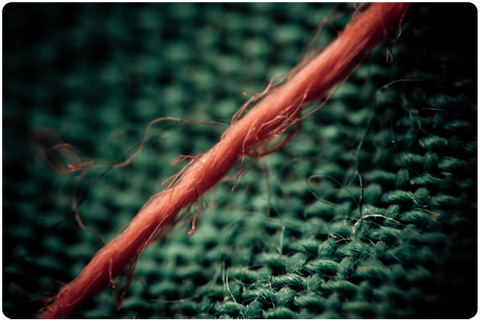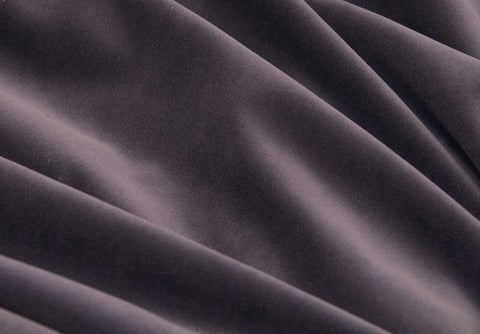How do you go about choosing the right fabric for your slipcover? Especially if you’re buying online, you may be tempted to ignore the fabric and choose a sofa cover that simply looks decent in the product image. But if you don’t check the fabric composition, you may find yourself disappointed. To us, fabric is everything; it determines your sofa cover’s look and feel, its performance over time, how often you will wash it (if it’s not machine-washable, you may not be very motivated), and much more.
If fabric terminology feels intimidating to you, fear not. Here are frequently asked questions about common scenarios, and our answers about the best slipcover fabrics. After that, dive deeper into a crash course on common slipcover fabrics and fibers and their special characteristics.
Best Slipcover Fabrics for Common Scenarios
For ready-made slipcovers, choose a slightly higher priced polyester-spandex blend for the best look, durability, comfort and overall value.
For custom slipcovers, the best fabric to use will depend on your priorities. For maximum durability, select a fabric with polyester fiber; for comfort, go with natural fibers like cotton. To compromise, choose a blend.
If your current sofa is such a hair magnet that it looks like a huge furry beast itself, we feel your pain. Our rec is to look for low-static fabrics. Fabrics made from natural fibers are the least staticky and offer a comfortable feel, too. On the other hand, polyester offers better durability for your energetic pets and, with some persistent searching, you may be able to find a few that are low-static and have a nice feel (just like we did for our covers).
The ready-made slipcovers that offer the best fit will always have a little stretch to them. In practical terms, this means blends that include polyester and spandex for the best performance. Our particular preference is a style that is chenille-like: soft to the touch, pleasing to the eye, non-wrinkling, durable, and suitable for all seasons.
For a clean, white look for a custom or non-stretch slipcover, look for a cover in linen or cotton duck for the best aesthetics.
Uh, no, unless you want to recreate the 1950s in your living room. Given the expanded world of couch covers and the huge pool of fabrics available now, there are much more attractive fabric options that offer full protection, and they won’t stick to your skin or crackle when you sit, either.
Perhaps surprisingly, getting a slipcover that doesn’t need to be constantly re-tucked due to slippage is less about the fabric and more about the add-ons. For example, sometimes a special coating or small rubber dots are applied to help keep the sofa cover in place. An easier solution is to go for multi-piece slipcovers (separate covers for cushions and the sofa base) that don’t require tucking at all.
Fabric is Fiber Content and Texture
Before we get too deep in, we must get two things clear:
-
Fiber
Fiber content lays the foundation for the fabric’s qualities, such as whether it’s stretchy, wrinkle-resistant, and stands up to wear
-
Texture
Texture is a result of a certain weave or knit method that is used to make a fabric out of fibers (and their blends). Different textures determine the look and feel of the finished fabric, ease of care and durability
Now we’re ready to have a look at different groups of Fibers.
Popular Fibers for All Types of Sofa Covers
- Polyester: great performance (durability), wrinkle-resistant, affordable, and easy to blend with other fibers, polyester is an obvious choice for any slipcover, especially the ready-made ones.
- Cotton: this popular fiber can withstand frequent cleaning, often right in your washing machine. The downside is that it both stains and wrinkles easily. When you come across cotton fibers in a slipcover fabric, you’ll usually find they’re part of a blend, e.g., 50% cotton.
- Polyester-cotton: this blend is very common, given that they combine the best of both worlds above: durable, fade-resistant, wrinkle-resistant, and dye easily.
Other Fibers for Custom Slipcovers
- Wool: Wool is a natural fiber offering durability. At the same time, it’s harder to clean and can feel scratchy, and when subjected to certain types of rubbing and wear, its texture can change—a process known as felting. Again, slipcover fabrics that contain wool are usually blended with other fibers.
- Linen: Compared to cotton, linen is more resistant to stains and also dries faster, but it is extremely prone to wrinkling. Linen fibers, made from the flax plant, are smooth and pleasant to the touch, and are often blended with cotton to offer more stretch. Linen is strong, absorbent, and well-suited to hot weather.
- Silk: Silk fibers both look and feel luxurious, and they keep their shape well. Because silk is easily stained, fades, and is quite expensive, it’s usually not the fiber of choice for high-use furniture.
Other Fibers for Ready-Made Slipcovers
Because one of the main benefits of ready-made sofa covers is affordability, their fabrics are chosen not just for comfort and aesthetics, but also for price and quality. Fabrics that use synthetic fibers have the advantage of lower prices, as well as workability and wrinkle resistance.
- Acrylic: Acrylic offers fade and wrinkle resistance, as well as significant elasticity. When blended with other fibers, the acrylic fibers usually provide enough stretch for the entire fabric.
- Rayon: Manufactured from cellulose, rayon is an inexpensive fiber, but fabrics woven from rayon often require dry-cleaning.
Now that you know the foundation of the fabric’s performance, let’s have a look at the most popular kinds of sofa cover styles (or textures). Even though they are normally used among custom slipcovers, any ready-made slipcover can repeat the touch and feel of these fabrics. (We’re not revealing any tricks here, though!)
Remember that these fabrics can be made from many different types of fibers, but their trademark textures are actually created from the weaving or knitting, rather than the fiber composition.
These fabric styles are:
-
Canvas (or cotton duck)

Especially durable, canvas fabric can be used both outdoors and indoors. Woven from cotton, flax, or hemp, canvas fabric also offers very little stretch. -
Chenille

Known for its velvety feel, chenille can be woven from both natural and synthetic fibers. Its benefits include durability, resistance to wear, thickness, good drape, and ability to retain warmth. Some also appreciate its slight sheen. -
Corduroy

Often made of cotton, corduroy fabric is marked by raised parallel lines (or “cords”) and is very durable. -
Damask

Woven into a pattern, usually floral, damask fabric is also usually reversible. The pattern is often formed using satin weaves of contrasting shine and luster. -
Microfiber

Usually stain-resistant, microfiber is a thin fabric woven from ultra-fine synthetic fibers. -
Muslin

Muslin is a very lightweight cotton fabric. -
Piqué (or marcella)

With a distinctive weave marked by a subtly raised pattern (like waffle, ribs, or honeycomb), pique is typically made from cotton. The fabric can range in thickness and sheerness. -
Satin

With one shiny side and one dull side, satin fabric can be woven from a variety of different fibers, including polyester, nylon, and silk. Its smoothness and sheen are achieved through the weave. -
Suede

Technically, suede is a soft, pliable leather with a napped finish, but synthetic suedes can also be made from polyester. Synthetic suede is stain-resistant and durable, and is a great choice for a luxe-looking slipcover. -
Taffeta

Lustrous on both sides, taffeta is a tight-woven and crisp fabric, often made from silk fibers. -
Twill

A fabric with a distinct, diagonally patterned weave, twill is often made from cotton fibers or a cotton-polyester blend. The weave lends durability to the fabric, which also resists stains. -
Velour

A plush knit fabric resembling velvet, velour has a thick pile and natural stretch.
Now that you’re fully equipped with the technical knowledge, you can also read a post on how you can apply it in home décor.
Custom vs. Ready-Made Slipcovers and What You Can Use in Each Case
Because custom slipcovers are tailor-made to fit the exact proportions of your sofa, they can use almost any textile. This is the biggest advantage of custom covers. The largest disadvantages are lack of versatility and the price tag, which can skyrocket over $1000 as you go for more expensive fabrics.
Ready-made slipcovers are practical and budget-friendly, but because they need to fit a wider range of couch shapes, the fabrics that offer the best fit will include a small percentage of spandex, or elastane, to offer some stretch to get the best looks. But if you’re a fan of a rustic style, then non-stretch cotton ready-made couch covers might work for you.
If you’d like a more in depth comparison between the two, check out our post.
What Did We Go With at Homeleon?
We have considered every possible stretch slipcover fabric and fiber mix to finally bring you a fabric that does everything we want it to at a reasonable price. (And we are demanding!). We chose stretch Chenille made out of a polyester-spandex blend.

It’s pleasing to the eye and touch, fade-resistant, wrinkle-resistant, durable, and machine-washable. It feels plush and soft. We are offering it in rich, covetable colors and the palette is still growing. Pretty magical, right? Check it out.

